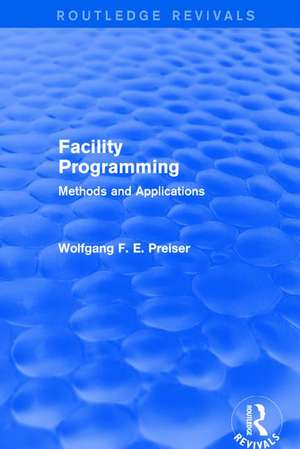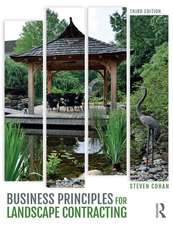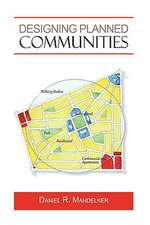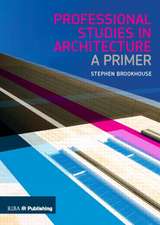Facility Programming (Routledge Revivals): Methods and Applications: Routledge Revivals
Autor Wolfgang F. E. Preiseren Limba Engleză Paperback – 18 ian 2018
| Toate formatele și edițiile | Preț | Express |
|---|---|---|
| Paperback (1) | 245.75 lei 6-8 săpt. | |
| Taylor & Francis – 18 ian 2018 | 245.75 lei 6-8 săpt. | |
| Hardback (1) | 827.64 lei 6-8 săpt. | |
| Taylor & Francis – 3 iun 2016 | 827.64 lei 6-8 săpt. |
Din seria Routledge Revivals
- 9%
 Preț: 801.69 lei
Preț: 801.69 lei - 8%
 Preț: 432.15 lei
Preț: 432.15 lei -
 Preț: 153.81 lei
Preț: 153.81 lei -
 Preț: 230.80 lei
Preț: 230.80 lei -
 Preț: 294.72 lei
Preț: 294.72 lei -
 Preț: 258.72 lei
Preț: 258.72 lei - 9%
 Preț: 764.34 lei
Preț: 764.34 lei - 9%
 Preț: 903.41 lei
Preț: 903.41 lei -
 Preț: 296.10 lei
Preț: 296.10 lei -
 Preț: 342.36 lei
Preț: 342.36 lei - 9%
 Preț: 606.35 lei
Preț: 606.35 lei -
 Preț: 317.54 lei
Preț: 317.54 lei - 9%
 Preț: 764.28 lei
Preț: 764.28 lei -
 Preț: 257.00 lei
Preț: 257.00 lei -
 Preț: 238.40 lei
Preț: 238.40 lei -
 Preț: 259.47 lei
Preț: 259.47 lei - 9%
 Preț: 903.80 lei
Preț: 903.80 lei -
 Preț: 326.26 lei
Preț: 326.26 lei -
 Preț: 258.66 lei
Preț: 258.66 lei -
 Preț: 294.97 lei
Preț: 294.97 lei -
 Preț: 308.89 lei
Preț: 308.89 lei -
 Preț: 199.85 lei
Preț: 199.85 lei -
 Preț: 347.49 lei
Preț: 347.49 lei -
 Preț: 295.04 lei
Preț: 295.04 lei -
 Preț: 389.39 lei
Preț: 389.39 lei -
 Preț: 257.00 lei
Preț: 257.00 lei -
 Preț: 343.21 lei
Preț: 343.21 lei - 9%
 Preț: 640.90 lei
Preț: 640.90 lei - 9%
 Preț: 619.48 lei
Preț: 619.48 lei -
 Preț: 228.88 lei
Preț: 228.88 lei -
 Preț: 257.67 lei
Preț: 257.67 lei -
 Preț: 245.10 lei
Preț: 245.10 lei -
 Preț: 258.52 lei
Preț: 258.52 lei -
 Preț: 258.72 lei
Preț: 258.72 lei -
 Preț: 368.93 lei
Preț: 368.93 lei -
 Preț: 246.37 lei
Preț: 246.37 lei - 9%
 Preț: 832.07 lei
Preț: 832.07 lei -
 Preț: 258.66 lei
Preț: 258.66 lei -
 Preț: 286.98 lei
Preț: 286.98 lei - 18%
 Preț: 695.85 lei
Preț: 695.85 lei - 9%
 Preț: 934.94 lei
Preț: 934.94 lei - 5%
 Preț: 231.22 lei
Preț: 231.22 lei -
 Preț: 267.15 lei
Preț: 267.15 lei -
 Preț: 200.66 lei
Preț: 200.66 lei - 9%
 Preț: 638.61 lei
Preț: 638.61 lei -
 Preț: 259.68 lei
Preț: 259.68 lei - 9%
 Preț: 1038.45 lei
Preț: 1038.45 lei -
 Preț: 389.43 lei
Preț: 389.43 lei -
 Preț: 302.13 lei
Preț: 302.13 lei -
 Preț: 302.25 lei
Preț: 302.25 lei
Preț: 245.75 lei
Preț vechi: 291.20 lei
-16% Nou
Puncte Express: 369
Preț estimativ în valută:
47.02€ • 49.23$ • 38.91£
47.02€ • 49.23$ • 38.91£
Carte tipărită la comandă
Livrare economică 05-19 aprilie
Preluare comenzi: 021 569.72.76
Specificații
ISBN-13: 9781138688483
ISBN-10: 1138688487
Pagini: 352
Dimensiuni: 210 x 240 x 24 mm
Greutate: 0.68 kg
Ediția:1
Editura: Taylor & Francis
Colecția Routledge
Seria Routledge Revivals
Locul publicării:Oxford, United Kingdom
ISBN-10: 1138688487
Pagini: 352
Dimensiuni: 210 x 240 x 24 mm
Greutate: 0.68 kg
Ediția:1
Editura: Taylor & Francis
Colecția Routledge
Seria Routledge Revivals
Locul publicării:Oxford, United Kingdom
Public țintă
Postgraduate, Professional, and UndergraduateCuprins
Preface; 1 Introduction: Responding to the Changing Context of Environmental Design Wolfgang F.E. Preiser; Part I: Facility Programming; 2 Restructuring the Hidden Program: Toward an Architecture of Social Change Murray Silverstein and Max Jacobsen 3 A Process for Adapting Exisiting Buildings for New Office Uses Gerald Davis 4 Programming across Cultures: A Cultural Food Preparation Center for Cochiti Indian Pueblo John P. Petronis, Lawrence S. Kline, and Richard R. Pugh 5 A Juvenile Services Center Program Jay D. Farbstein 6 The Support-Infill Concept as a Methodology for User Participation in Mass Housing Projects Eric Dluhosch 7 Environmental Programming for Human Needs Walter H. Moleski; Part II: Programming for Architecture and Design; 8 Habitable Schools: Programming for a Changing Environment John M. Kurtz 9 Recycling Institutional Buildings: A Data Base Technique Richard P. Dober 10 Downtown Malls: A Blueprint for Success Michael C. Cunningham with Barbara Flynn 11 User Needs in Residential Areas: Martin Luther King Square, San Francisco Herbert McLaughlin 12 Health Care Facilities George Agron with Margaret Moore; Part III Research for Facility Programming; 13 Specifying for User Needs in Office Environments James L. Binkley and Jams A. Parker 14 Post Construction Evaluation and Guidelines for Elderly Housing Sandra C. Howell 15 Habitability Programming for U.S. Naval Ships Michael C. Heffron 16 Parameters of Habitable Environments Edward C. Wortz, David P. Nowlis, and Harold H. Watters 17 Computer-Aided Facilities Programming in Environmental Design Education and Research Kaiman Lee, Richard Chalmers, and Grant Genova 18 Programming Guidance for the Institutional Client Alan C. Green; Part IV: Prospects for Facility Programming; 19 Prospects for the Field of Facility Programming John P. Eberhard; Author Index; Subject Index
Descriere
First published in 1978, the objective of this book is to provide an authoritative and selective overview of current, user-orientated programming methods within the field of environmental design. The 19 chapters compiled in this volume describe procedures and the information content of innovative approaches used by leading programming experts in the private and institutional sectors. Emphasis is placed on a qualitative and illustrative focus of selected approaches to environmental programming with the eventual occupants in mind. The chapter groupings are intended to reflect three major areas of professional engagement that serve the field of facility programming.













